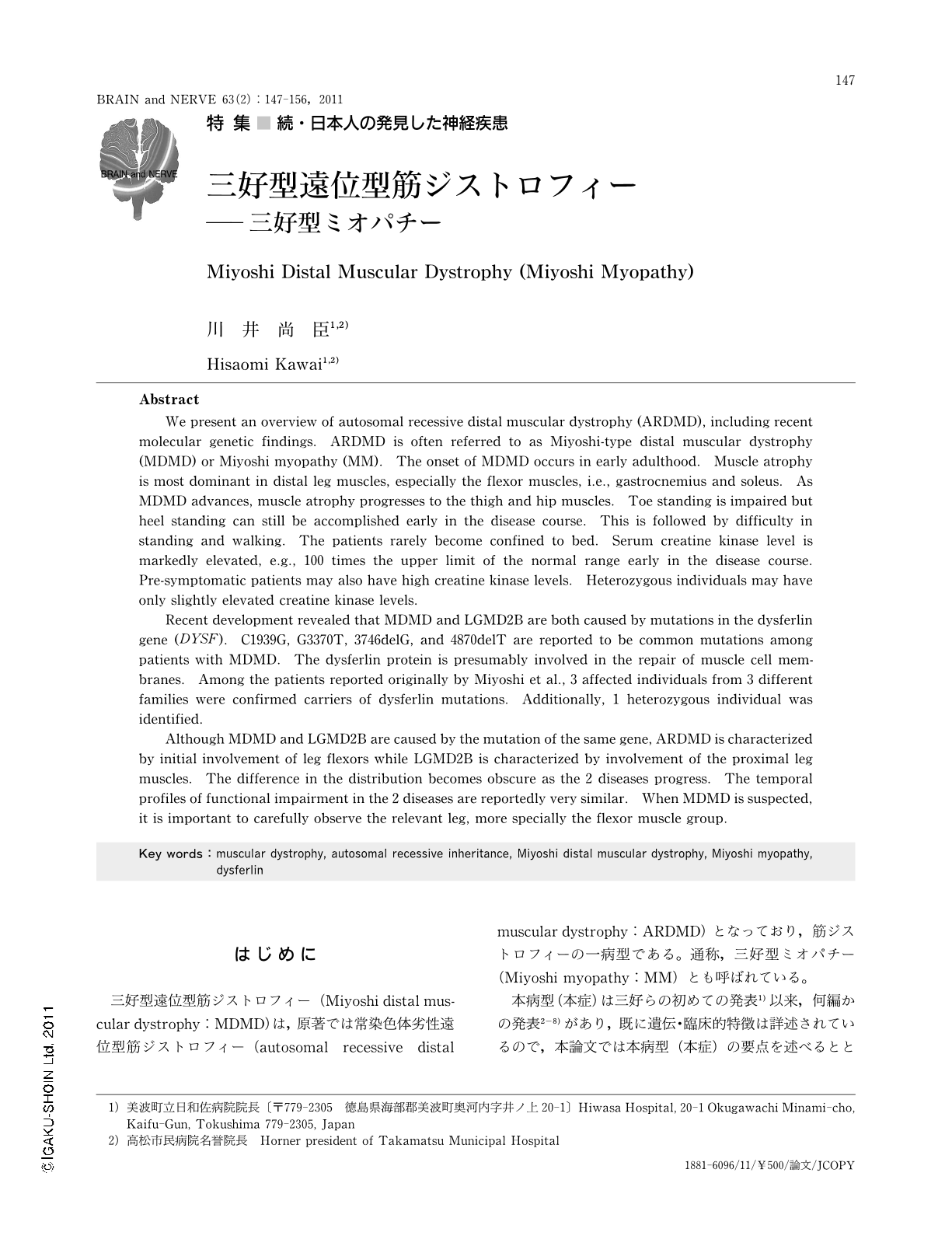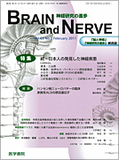Japanese
English
- 有料閲覧
- Abstract 文献概要
- 1ページ目 Look Inside
- 参考文献 Reference
はじめに
三好型遠位型筋ジストロフィー(Miyoshi distal muscular dystrophy:MDMD)は,原著では常染色体劣性遠位型筋ジストロフィー(autosomal recessive distal muscular dystrophy:ARDMD)となっており,筋ジストロフィーの一病型である。通称,三好型ミオパチー(Miyoshi myopathy:MM)とも呼ばれている。
本病型(本症)は三好らの初めての発表1)以来,何編かの発表2-8)があり,既に遺伝・臨床的特徴は詳述されているので,本論文では本病型(本症)の要点を述べるとともに臨床的諸問題点についても言及したい。併せて,本病型関連の最近の分子遺伝学的研究の進展についても触れる。
「三好型遠位型筋ジストロフィー」あるいは「三好型ミオパチー」という名称は,もちろん三好らが自ら付けた名称ではない。原著6-8)は,前述のごとく「常染色体劣性遠位型筋ジストロフィー」となっている。しかし,本邦では早くから三好型遠位型筋ジストロフィーあるいはそれに類似の名称,もしくは三好型ミオパチーの名称が使われており9-11),欧米の論文12-14)でも次第にそれらの名称が使われるようになってきた。そして,最近では国の内外で「三好型ミオパチー」,「Miyoshi myopathy」,あるいは「三好型遠位型筋ジストロフィー」,「Miyoshi distal muscular dystrophy」が広く使われている15-19)。
以下,本文ではARDMDあるいはMDMDを本病型,三好型あるいは三好型遠位型筋ジストロフィーと記することにする。
本病型は,責任遺伝子ならびに遺伝子異常が明らかにされ病態の解明にも著しい進展がみられた話題の筋ジストロフィーである。また,常染色体劣性肢帯型筋ジストロフィーB型(limb-girdle muscular dystrophy, type 2B:LGMD2B)の責任遺伝子が三好型と同じであることもこの分野の臨床,研究に問題を提起している(後述,各項参照)。
Abstract
We present an overview of autosomal recessive distal muscular dystrophy (ARDMD), including recent molecular genetic findings. ARDMD is often referred to as Miyoshi-type distal muscular dystrophy (MDMD) or Miyoshi myopathy (MM). The onset of MDMD occurs in early adulthood. Muscle atrophy is most dominant in distal leg muscles, especially the flexor muscles, i.e., gastrocnemius and soleus. As MDMD advances, muscle atrophy progresses to the thigh and hip muscles. Toe standing is impaired but heel standing can still be accomplished early in the disease course. This is followed by difficulty in standing and walking. The patients rarely become confined to bed. Serum creatine kinase level is markedly elevated, e.g., 100 times the upper limit of the normal range early in the disease course. Pre-symptomatic patients may also have high creatine kinase levels. Heterozygous individuals may have only slightly elevated creatine kinase levels.
Recent development revealed that MDMD and LGMD2B are both caused by mutations in the dysferlin gene (DYSF). C1939G, G3370T, 3746delG, and 4870delT are reported to be common mutations among patients with MDMD. The dysferlin protein is presumably involved in the repair of muscle cell membranes. Among the patients reported originally by Miyoshi et al., 3 affected individuals from 3 different families were confirmed carriers of dysferlin mutations. Additionally, 1 heterozygous individual was identified.
Although MDMD and LGMD2B are caused by the mutation of the same gene,ARDMD is characterized by initial involvement of leg flexors while LGMD2B is characterized by involvement of the proximal leg muscles. The difference in the distribution becomes obscure as the 2 diseases progress. The temporal profiles of functional impairment in the 2 diseases are reportedly very similar. When MDMD is suspected,it is important to carefully observe the relevant leg,more specially the flexor muscle group.

Copyright © 2011, Igaku-Shoin Ltd. All rights reserved.


